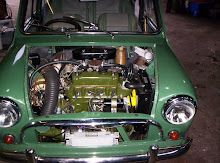Earlier instruction books call for attention at intervals of 1,000, 3,000, 6,000 and 12,000 miles. There is a considerable body of technical opinion, however, to support the contention that most manufacturers' lubrication charts err on the side of safety, necessarily making allowance for the owner who tends to postpone routine servicing to the last minute. Provided that maintenance is carried out conscientiously, the periods between the various jobs can, in many cases, be appreciably extended. This is borne out by the fact that the current servicing recom¬mendations specify attention only at 3,000,6,000 and 12,000-mile intervals. On a car in good condition, in fact, it should not be necessary to lubricate the various chassis points more frequently than at 3,000-mile intervals unless it is operating under very adverse conditions of heat and unsurfaced roads, or continuous mud and slush.
Fig. 7. An under-bonnet view of the Mini. Many of the items requiring servicing are to be found in the engine compartment. The arrangement is typical of most of the range of Minis
Dynamo-charging regulator and cut-out
1. Brake fluid reservoir
2. Clutch fluid reservoir
3. Carburettor air-intake filter
4. Carburettor
5. Oil filler cap
6. Thermostat housing
7. Windscreen wiper
9. Radiator filler cap
10. Windscreen washer water supply
11. Clutch-operating cylinder
12. Ignition coil
13. Ignition distributor
14. Sparking plug
15. Dynamo or generator
16. Cooling fan
The only exception to the general rule concerns the question of changing the engine and transmission oil. An oil change should not be deferred beyond the 6,000-mile limit if a manual transmission is fitted and 3,000 miles if the car has an automatic transmission; it may, in fact, be advisable to change the oil more frequently when the car is operating under adverse conditions, such as frequent cold starts and short runs.



0 comments:
Post a Comment